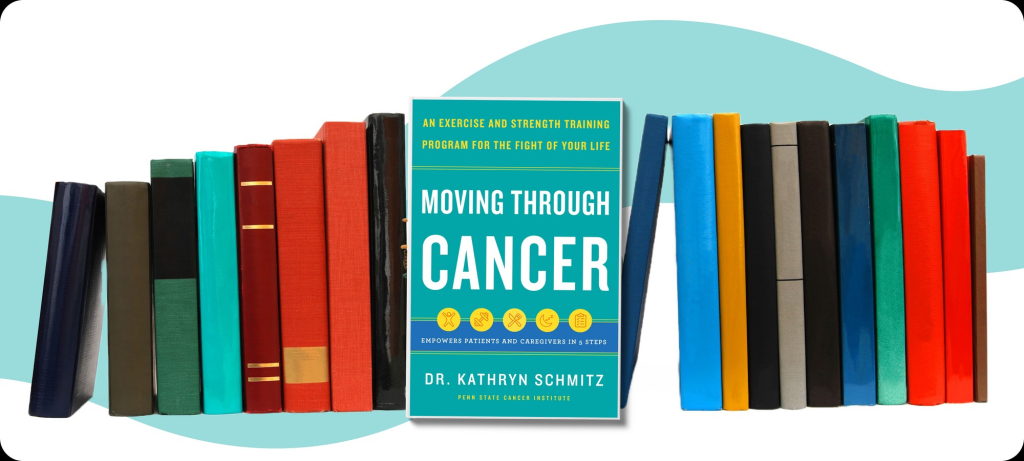“Every cancer patient and caregiver needs to read this book. If you’re affected by cancer, it will inspire you to get moving, show you what you need to do (even on your darkest days) and hold your hand every step of the way. If you treat cancer patients, it will remind you why exercise should be the first treatment you recommend.” – Dr. Liz O'Riordan, coauthor of ‘The Complete Guide to Breast Cancer’
In the past, the prevailing belief was that cancer patients should avoid physical activity and conserve their energy for fighting the disease. Even when experts from the American College of Sports Medicine (ACSM) gathered ten years ago to promote exercise as safe for cancer patients, their primary message was focused on convincing medical professionals that physical activity was not harmful during treatment.
However, a decade later, the perspective drastically shifted. The new message from ACSM highlighted the dangers of not exercising during cancer treatment, emphasising that patients may be harming themselves by avoiding physical activity. Understanding the crucial importance of incorporating exercise into the cancer treatment journey is the main topic of ‘Moving Through Cancer: An Exercise and Strength-Training Program for the Fight of Your Life’.
Author’s background

Mary Kathryn Haltiwanger Schmitz is an American exercise physiologist, currently serving as the Associate Director of Population Sciences at Penn State University College of Medicine and a Full Professor at the Perelman School of Medicine at the University of Pennsylvania.

She started her career at the University of Minnesota’s School of Public Health and later moved to the University of Pennsylvania due to its strong exercise physiology program. Schmitz conducted research on women with lymphedema and strength training, finding positive effects on symptoms, strength, body fat percentage, and quality of life.
Her work focused on the connection between physical activity and diseases, leading to studies on the effectiveness of YMCA memberships combined with supervised strength training classes for overweight and obese women, and a randomised trial of weight lifting for breast cancer survivors.
As an associate professor, Schmitz established the SHE study (Strong, Healthy and Empowered), demonstrating that resistance exercise slows middle-age weight gain. She also played a key role in developing exercise guidelines for cancer survivors and received recognition for her lymphedema research.
She led a trial examining the relationship between lymphedema and weight loss in overweight breast cancer survivors as part of a $10 million grant from the National Cancer Institute. In 2017, Schmitz was elected president-elect of the American College of Sports Medicine and was nominated for UPenn’s Innovator of the Year Award.
What is the book about?

The book opens with a valuable perspective on how the medical field’s historical advice against exercising during cancer has been debunked by scientific studies over the years, establishing the credibility of Dr. Schmitz and the book’s content.
It provides step-by-step instructions and practical suggestions for effectively exercising during various cancer treatments, making it a valuable resource for anyone undergoing chemotherapy, radiation, or surgery. While the book caters to all levels of exercise experience, including seasoned athletes, the concepts and ideas presented are helpful in adapting one’s fitness routine during treatment.
Key takeaways from ‘Moving Through Cancer’

1Exercise and movement can bring great benefits to people living with cancer
The book ‘Moving Through Cancer’ emphasiaes the well-established benefits of exercise for cancer patients and survivors. Research dating back to 1938 has shown the positive impact of physical activity on cancer outcomes. More recent studies have demonstrated that exercise can reduce the risk of cancer-specific mortality and improve overall quality of life.
Various studies have shown that exercise during cancer treatment can change the trajectory of the disease, slow tumour growth, and increase the chances of survival. Specific exercise programs have been developed to address various cancer-related issues, such as anxiety, depression, fatigue, physical function, bone health, sleep, and lymphedema.
2Cancer-related fatigue is extremely severe, but exercise is the most effective way to combat it
Cancer-related fatigue is a common and debilitating side effect of cancer treatment. Patients often describe it as an overwhelming exhaustion that affects both physical and mental energy. Unlike regular tiredness, rest may not alleviate cancer fatigue. The exact cause of cancer fatigue is not fully understood, but it can result from treatment or cancer itself.
Despite the extreme fatigue experienced by cancer patients, exercise is considered the most effective treatment for combatting this fatigue. Numerous studies have shown that exercise significantly reduces fatigue and improves vitality. Exercise has even outperformed drug interventions for fatigue.
3It’s very important to maintain the motivation to move
Finding motivation to exercise during cancer treatment can be challenging, but it is crucial for reaping the benefits. Personal motivations differ for each individual, and identifying them is essential for staying committed to an exercise regimen.
Using techniques like motivational interviewing, individuals can discover their reasons for change and create a list of factors driving their desire to exercise. The ‘10-minute’ rule is a widely accepted approach among cancer patients who exercise during and after treatment. A patient should simply start exercising, and if they feel better after 10 minutes, then continue. If they feel worse, then they should stop. When motivation drops, it’s great to revisit the list of motivations for exercising and consider the small steps one can take to keep themselves on track.
4Keeping a log of activities is also crucial during training
It helps track progress and recognise patterns in how cancer and treatments affect one’s activities and well-being. The log provides insights into energy levels and helps establish a new normal during various phases of a cancer-treatment journey.
5Using SMART goals is good for setting exercise objective
It’s recommended to use the SMART formula for setting exercise objectives: specific, measurable, achievable, relevant, and time-bound. This approach breaks down one’s goals into manageable pieces, making them less overwhelming and more achievable.
It’s better to choose exercises you enjoy, as any form of activity is better than none. Even small movements or occasional physical work can contribute to fitness during cancer treatment.
Another good piece of advice is to exercise with a friend or family member for increased motivation, enjoyment, and better results. Exercising outdoors, known as ‘forest bathing,’ has proven benefits, such as improved mood, self-esteem, and reduced tension.
6It’s better to start resistance training before treatment
During cancer treatment, healthy cells play a vital role in supporting recovery, but their effectiveness depends on the energy available. If a patient starts treatment with a higher fitness level, their body will have more resources to deal with the challenges, preventing the losses in fitness typically seen during treatment.
Training before treatment focuses on gaining and maintaining muscle mass, which is crucial for providing energy reserves during treatment and aiding in recovery afterwards.
The goal is not solely to increase strength, but to build muscle mass, as muscles atrophy if not used. Having more muscle at the start of treatment ensures that a patient has some energy reserves to cope with the physical demands. Resistance exercise is essential before treatment to build and preserve muscle mass. This preparation period offers an opportunity to take control of one’s body and prepare it for the challenges ahead.
7Correct Eating becomes a part of the medical plan for those in treatment
During cancer treatment and survivorship, practical nutrition tips include focusing on long-term healthy choices while enjoying food and not getting stressed over occasional indulgences.
It’s recommended to enlist friends or family to help with healthy meal options, utilise meal delivery services, and stay hydrated with various fluids. Patients should prioritise fruits and vegetables, experiment with new ones, and simplify shopping lists. It’s ok to consider meal replacements for sufficient protein intake. Patients should aim for stable weight and be systematic in testing problematic foods for gastrointestinal issues. It’s good to try cooking to boost self-efficacy and creativity and cultivate a connection to food by growing your own.
Table of contents

- Part one: How exercise helps
- Chapter 1: It starts with a phone call
- Chapter 2: Now what?
- Chapter 3: The scientific evidence
- Chapter 4: Finding motivation
- Part two: The moving through cancer program
- Chapter 5: Prehabilitation (training before treatment)
- Chapter 6: Surgery
- Chapter 7: Chemo and other infusion therapies
- Chapter 8: Radiation
- Chapter 9: Hormonal therapies
- Chapter 10: Reconstruction
- Chapter 11: Post-treatment
- Chapter 12: Survivorship
- Part three: Supports and successes
- Chapter 13: Sleep
- Chapter 14: Nutrition
- Chapter 15: Caregivers
- Chapter 16: Athletes
- Acknowledgments
- Notes
- About the authors
Overall rating & strengths and weaknesses, according to readers’ reviews

Strengths
The book is very informative, real, motivating, and empowering.
The writing strikes a good balance between interesting scientific information and touching personal stories.
Includes practical advice and exercises.
Can be a great read for different audiences, including patients, caregivers and professionals.
Weaknesses
The content primarily mentions traditional cancer treatments, such as chemotherapy, radiation, and surgery, but it overlooks the significant impact of immunotherapy, a revolutionary approach that has rapidly transformed the landscape of cancer treatment over the past five years.
The book’s case studies and interviews predominantly feature women and don’t provide much information on men.
Best quotes from ‘Moving Through Cancer’

“There is no way to guarantee what your experience as a cancer patient will be, but I can guarantee that moving – getting some exercise, even just a little bit – will make you feel better. Study after study has shown that exercise leads to better quality of life, fitness, energy, and strength.”
“It is a very common experience to feel angry after a cancer diagnosis. You can feel like your body has let you down. This is true of everyone, but might be particularly true for people who are fit, have a normal weight, and eat a healthy diet. They feel like they’ve done everything right and yet they still got cancer.”
“This is the nature of cancer. It is filled with uncertainty. It is a blur of anxiety and confusion. It is a total loss of control over your body. It’s being forced to make decisions without feeling like you understand them. It’s realizing that you don’t even know the questions you should be asking. And even the very best doctors in the world do not know what your journey as a cancer patient is going to be.”
Final takeaway

‘Moving Through Cancer’ by Dr. Kathryn Schmitz is a compelling and motivating read that emphasises the necessity of overcoming oneself and engaging in physical exercise during the challenging journey of cancer treatment. The book underscores the transformative power of exercise in combating cancer-related fatigue and improving overall well-being. By sharing inspiring case studies and expert insights, it highlights the importance of staying active even amidst the physical and emotional struggles of cancer treatment. The book’s approachable and evidence-based guidance empowers readers to embrace exercise as an essential tool for managing the side effects of cancer treatment, enhancing vitality, and regaining a sense of control over their bodies and lives. It serves as a valuable resource, encouraging individuals to embark on a journey of self-discovery and resilience, finding strength and hope through movement during their cancer battle.
Where to buy
You can buy ‘Moving Through Cancer’ by Dr. Kathryn Schmitz on Amazon, where it’s available in hardcover, audio and Kindle formats.
Receive Exclusive Tips & Weekly Digest – subscribe to our newsletter







